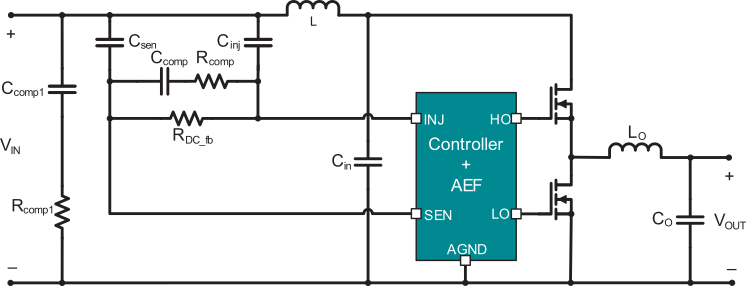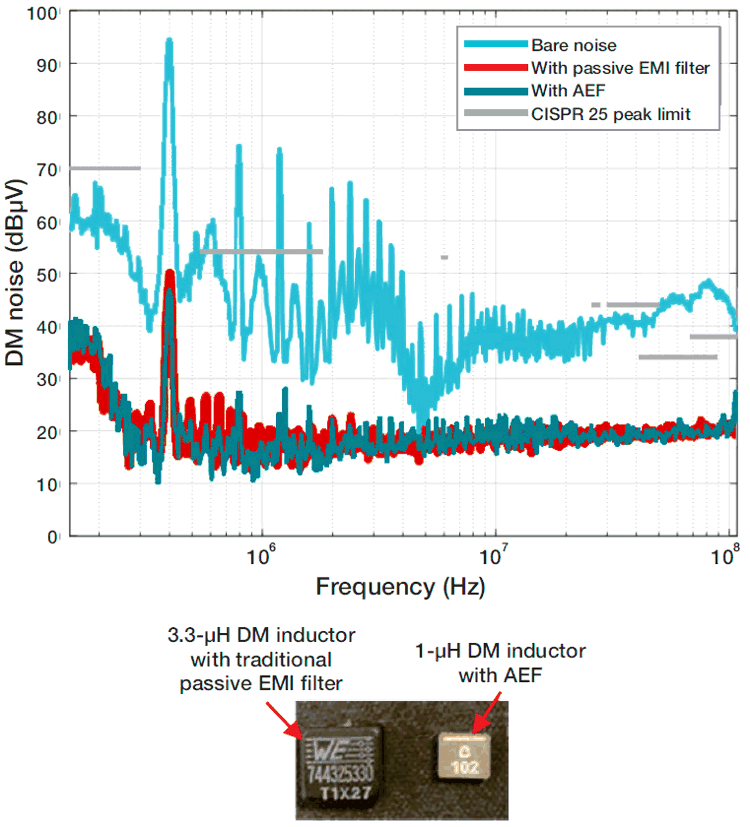SLYY200A April 2021 – December 2023 LM25149 , LM25149-Q1 , LM5156-Q1 , LM5157-Q1 , LM53635-Q1 , LM60440-Q1 , LM61460-Q1 , LM61495-Q1 , LMQ62440-Q1 , LMR33630-Q1 , LMS3655-Q1 , TPS55165-Q1 , UCC12040 , UCC12050
- 1
- Overview
- At a glance
- What is EMI?
- Conventional methods to reduce EMI in the low- and high-frequency ranges
- Innovations in reducing low-frequency emissions
- Spread spectrum
- Active EMI filtering
- Cancellation windings
- Innovations in reducing high-frequency emissions
- HotRod™ package
- Enhanced HotRod QFN
- Integrated input bypass capacitor
- True slew-rate control
- EMI modeling capabilities
- Low-frequency EMI designs using WEBENCH® design tool
- Conducted and radiated EMI results published in data sheets
- Conclusion
- Keep product categories for low EMI
Active EMI filtering
To substantially improve emissions in the low-frequency spectrum, the LM25149-Q1 buck controller incorporates an active EMI filtering approach. The integrated active EMI filter reduces DM conducted emissions at the input by acting as an effective low-impedance shunt. Figure 13 shows how the active EMI filter of the buck controller connects to the input line. The sense and inject pins hook up to the input through their respective capacitors. The active element within the active EMI filter block amplifies the sensed signal and injects an appropriate anti-polarity signal through the inject capacitor in order to minimize the overall disturbance on the input line. This reduces the filtering burden on the passive elements needed, thereby reducing their size, volume and cost.
 Figure 13 Active EMI filter showing the
sense, inject capacitors and components for compensation.
Figure 13 Active EMI filter showing the
sense, inject capacitors and components for compensation.Figure 14 shows the EMI measurement results of a buck converter operating at a 400-kHz switching frequency, comparing the active and passive EMI filtering approaches. To effectively meet the CISPR 25 Class 5 spectral mask, the passive EMI filter needs a 3.3-μH DM inductor with a 10-μF DM capacitor. The active filtering approach can achieve the same effective attenuation with a DM inductor of only 1 μH along with 100-nF sense and inject capacitors. This helps reduce the size and volume of the passive filter to about 43% and 27% of the original values, respectively. For higher-current converters, it is possible to obtain further benefits in cost and efficiency from a reduction in inductor DC resistance.
 Figure 14 EMI attenuation obtained using
passive and active filtering and comparison of the passive inductor needed for
filtering in both approaches for a 12-V input, 5-V/5-A output buck
converter.
Figure 14 EMI attenuation obtained using
passive and active filtering and comparison of the passive inductor needed for
filtering in both approaches for a 12-V input, 5-V/5-A output buck
converter.